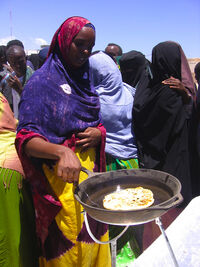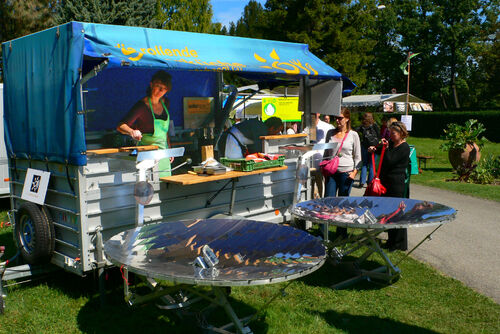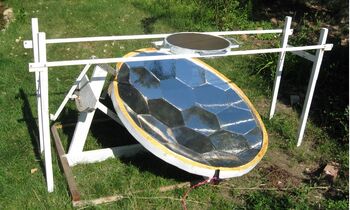Tom Sponheim (talk | contribs) No edit summary |
Tom Sponheim (talk | contribs) mNo edit summary Tag: sourceedit |
||
| (26 intermediate revisions by 3 users not shown) | |||
| Line 1: | Line 1: | ||
| + | {{GoogleTranslateLinks}} |
||
| − | I do think you are right to consider parabolic solar cookers for making flat bread. I am sorry to say that I have never eaten Iraqi style flat bread. However, I assume it requires a high temperature to cook properly, and high temperatures are not easy to obtain in many types of solar cookers. |
||
| + | {{Updated|11|4|16}} |
||
| + | [[Image:Sun_Fire_Cooking_flatbread.jpg|thumb|200px|A woman involved with the [[Sun Fire Cooking]] project cooks [[flatbread]] in a parabolic solar cooker in [[Somalia]].]] |
||
| + | '''Flatbread''' in its many forms (tortillas, ingera, etc.) is an important staple food around the world. [[Panel cooker]]s and [[box cooker]]s do not get hot enough to cook flatbreads, although they could be specially designed for the purpose. [[Parabolic_reflectors|Parabolic cookers]] are the most likely candidates as well as cookers like the [[Devos Solar Cooker]] and the very large [[Scheffler Community Kitchen]]. |
||
| + | The Ethiopians and Eritreans use a clay griddle for preparing their ''ingera''. This type of griddle is not conductive enough to allow it to be heated hot enough and evenly enough by most solar cookers. We have received two reports of the use of cast iron griddles made in China. These worked much better than the ones made of clay. When ''ingera'' is cooked in the traditional way over a wood fire, the correct temperature of the griddle is {{Degree|180}}. |
||
| − | In our way of thinking, there are three important categories of solar cookers--panel cookers (such as the [[Solar Cookers International|SCI]] [[CooKit]]), box cookers and concentrating (often parabolic or paraboloid) cookers. Panel cookers are not good for the flat breads I know about. Most box cookers do not get hot enough, although I think they could be specially designed for the purpose. Parabolic cookers do seem like the most likely. |
||
| + | [[Image:Creperie_Solaire.jpg|thumb|none|500px|[[Michael Götz]] has taken his 'Crêperie Solaire' to many music festivals or ecology fairs where visitors get their first culinary experience with solar cooking.]] |
||
| + | =={{HeadingNews}}== |
||
| + | [[File:Gallagher_Solar_Injera_Cooker.jpg|thumb|350px|[[Solar Injera Cooker]]]] |
||
| + | *'''December 2010:''' After he retired, [[Alan Gallagher]], a physicist, decided to take his interest in solar energy in a whole new direction: He decided to design, build, and test a unique large-area frying pan heated by the Sun’s energy. The new parabolic solar frying pan, the [[Solar Injera Cooker]], was specifically tailored to the cooking of injera bread in East Africa. Other types of solar cookers are not well-suited for frying. In villages, a typical “slice” of injera bread can be more than half a meter in diameter. The [[parabolic solar cooker]] can be used eight hours a day throughout the year. [http://jila.colorado.edu/content/incredible-solar-bread-machine More Information...] |
||
| + | ==See also== |
||
| − | You may already know about our [http://www.solarcooking.org Solar Cooking Archive] site on the internet. If you click on the section called "build a solar cooker" you will find instructions for building a variety of box cookers, panel cookers, and--at the bottom--some parabolic cookers. The parabolic cookers shown tend to be the low-cost, low-technology type and may not really serve your purposes fully. But studying those designs may give you some ideas. |
||
| + | *[[Solar Injera Cooker]] |
||
| + | *[[Devos Solar Cooker]] |
||
| + | *[[Sun Fire Cooking]] |
||
| + | *[[Scheffler Community Kitchen]] |
||
| + | *[[Sabur Achtari]] has built a solar tandori at the [[Afghan Bedmoschk Solar Centre]]. |
||
| ⚫ | |||
| − | Another section of the Solar Cooking Archive is called "design and science of solar cookers." In that section, you may be interested in the articles called "Making a Parabolic Reflector out of a Flat Sheet" and "A Parabolic Cooker for Unattended Cooking." If you are interested in the mathematics and theory of parabolic designs, you might like to read the article called "Theories Behind a Chinese Reflective Solar Cooker." |
||
| ⚫ | |||
| − | The most common type of parabolic solar cooker in the world is likely to be the "butterfly" type with two not-quite-parabolic reflectors. These are very common in China. You might find something of interest in our latest newsletter which discusses a very popular Chinese solar cooker and includes a photo. You can find that article on the internet [http://solarcooking.org/newsletters/scrnov06.htm#Chinese_company here. |
||
| + | *[http://www.ashdenawards.org/winners/ertc Fuel efficient stoves for baking injera bread] |
||
| − | |||
| + | [[Category:Foods]] |
||
| ⚫ | |||
| ⚫ | |||
Latest revision as of 18:56, 10 August 2017
|
Last edited: 4 November 2016
|

A woman involved with the Sun Fire Cooking project cooks flatbread in a parabolic solar cooker in Somalia.
Flatbread in its many forms (tortillas, ingera, etc.) is an important staple food around the world. Panel cookers and box cookers do not get hot enough to cook flatbreads, although they could be specially designed for the purpose. Parabolic cookers are the most likely candidates as well as cookers like the Devos Solar Cooker and the very large Scheffler Community Kitchen.
The Ethiopians and Eritreans use a clay griddle for preparing their ingera. This type of griddle is not conductive enough to allow it to be heated hot enough and evenly enough by most solar cookers. We have received two reports of the use of cast iron griddles made in China. These worked much better than the ones made of clay. When ingera is cooked in the traditional way over a wood fire, the correct temperature of the griddle is 180 °C (356 °F).

Michael Götz has taken his 'Crêperie Solaire' to many music festivals or ecology fairs where visitors get their first culinary experience with solar cooking.
News[]

- December 2010: After he retired, Alan Gallagher, a physicist, decided to take his interest in solar energy in a whole new direction: He decided to design, build, and test a unique large-area frying pan heated by the Sun’s energy. The new parabolic solar frying pan, the Solar Injera Cooker, was specifically tailored to the cooking of injera bread in East Africa. Other types of solar cookers are not well-suited for frying. In villages, a typical “slice” of injera bread can be more than half a meter in diameter. The parabolic solar cooker can be used eight hours a day throughout the year. More Information...
See also[]
- Solar Injera Cooker
- Devos Solar Cooker
- Sun Fire Cooking
- Scheffler Community Kitchen
- Sabur Achtari has built a solar tandori at the Afghan Bedmoschk Solar Centre.
